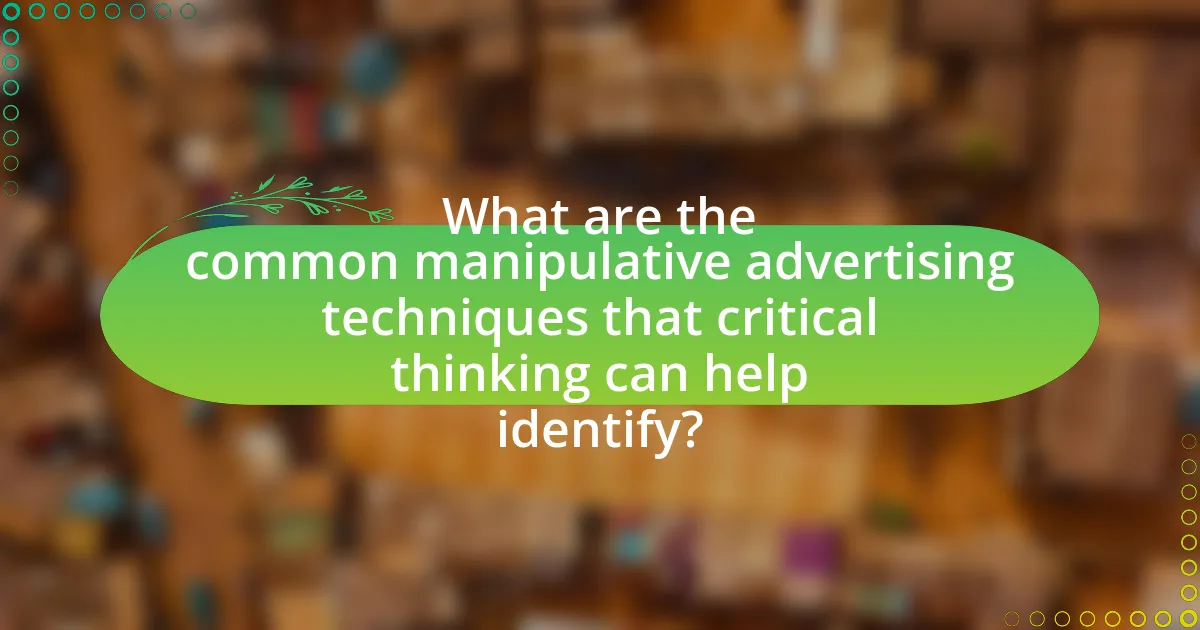The article focuses on the importance of teaching critical thinking skills to combat manipulative advertising. It defines critical thinking as the ability to analyze information objectively and make reasoned judgments, which is essential for consumers to discern persuasive tactics from factual information. The article outlines how critical thinking skills help individuals evaluate advertisements, identify biases, and recognize emotional appeals, ultimately leading to more informed purchasing decisions. It also discusses the role of education in developing these skills, effective teaching methods, and practical strategies for consumers to resist manipulative advertising techniques. Additionally, it highlights common manipulative tactics used in advertising, such as emotional appeals and misleading statistics, and emphasizes the significance of skepticism in evaluating advertising messages.

What are critical thinking skills and why are they important in combating manipulative advertising?
Critical thinking skills are the ability to analyze information objectively, evaluate evidence, and make reasoned judgments. These skills are crucial in combating manipulative advertising because they enable individuals to discern between persuasive tactics and factual information, allowing them to make informed decisions. For instance, research indicates that consumers who employ critical thinking are less likely to be swayed by misleading claims, as they can identify logical fallacies and emotional appeals used in advertisements. This analytical approach helps protect individuals from being exploited by deceptive marketing strategies, ultimately fostering a more informed and resilient consumer base.
How do critical thinking skills help individuals analyze advertisements?
Critical thinking skills enable individuals to critically assess advertisements by evaluating the claims, identifying biases, and discerning persuasive techniques used. These skills allow consumers to question the validity of the information presented, recognize emotional appeals, and analyze the underlying motives of advertisers. For instance, studies show that individuals trained in critical thinking are more adept at spotting logical fallacies and misleading statistics in ads, leading to more informed purchasing decisions. This analytical approach helps mitigate the impact of manipulative advertising tactics, fostering a more discerning consumer base.
What specific critical thinking skills are most relevant to advertising analysis?
The specific critical thinking skills most relevant to advertising analysis include analytical reasoning, evaluation of evidence, and the ability to identify biases. Analytical reasoning allows individuals to dissect advertisements, understanding the underlying messages and techniques used to persuade consumers. Evaluation of evidence is crucial for assessing the credibility of claims made in advertisements, enabling consumers to distinguish between factual information and misleading statements. Identifying biases helps individuals recognize the emotional appeals and manipulative tactics employed in advertising, fostering a more informed and critical approach to media consumption. These skills collectively empower consumers to navigate the complexities of advertising effectively.
How can critical thinking skills prevent susceptibility to manipulative tactics?
Critical thinking skills can prevent susceptibility to manipulative tactics by enabling individuals to analyze information critically and question the motives behind persuasive messages. When individuals apply critical thinking, they assess the validity of claims, recognize logical fallacies, and differentiate between emotional appeals and factual evidence. Research indicates that individuals trained in critical thinking are less likely to be influenced by deceptive advertising techniques, as they can identify inconsistencies and biases in the information presented. For example, a study published in the Journal of Advertising Research found that consumers with strong critical thinking skills were better at detecting misleading advertisements, leading to more informed decision-making.
What role does education play in developing critical thinking skills?
Education plays a crucial role in developing critical thinking skills by providing structured environments where individuals can analyze, evaluate, and synthesize information. Through curricula that emphasize inquiry-based learning, students engage in problem-solving activities that require them to question assumptions and consider multiple perspectives. Research indicates that students exposed to critical thinking frameworks, such as those outlined by the Foundation for Critical Thinking, demonstrate improved analytical abilities and decision-making skills. This educational approach equips learners with the tools necessary to discern manipulative advertising tactics, fostering a more informed and discerning consumer base.
How can educators incorporate critical thinking into their curriculum?
Educators can incorporate critical thinking into their curriculum by integrating problem-based learning activities that require students to analyze, evaluate, and create solutions to real-world issues, such as manipulative advertising. This approach encourages students to question the validity of information, assess the credibility of sources, and develop reasoned arguments. Research by the American Association of Colleges and Universities indicates that active learning strategies, including collaborative projects and case studies, significantly enhance critical thinking skills among students. By embedding these methods into lessons, educators can effectively foster a critical mindset that empowers students to navigate and challenge advertising tactics.
What teaching methods are most effective for fostering critical thinking?
The most effective teaching methods for fostering critical thinking include inquiry-based learning, Socratic questioning, and problem-based learning. Inquiry-based learning encourages students to ask questions and explore topics deeply, promoting analytical skills. Socratic questioning stimulates critical dialogue, allowing students to examine their beliefs and assumptions. Problem-based learning engages students in real-world scenarios, requiring them to apply critical thinking to find solutions. Research by Hattie (2009) indicates that these methods significantly enhance students’ critical thinking abilities, as they actively involve learners in the process rather than passively receiving information.

What are the common manipulative advertising techniques that critical thinking can help identify?
Common manipulative advertising techniques include emotional appeals, misleading statistics, and false comparisons. Emotional appeals target feelings to influence consumer behavior, often bypassing rational analysis. Misleading statistics present data in a way that exaggerates benefits or minimizes drawbacks, leading consumers to make uninformed decisions. False comparisons create a deceptive context by comparing products in a way that misrepresents their true value or effectiveness. Critical thinking skills enable individuals to analyze these techniques, question the validity of claims, and make informed choices based on evidence rather than emotional manipulation.
How do emotional appeals influence consumer behavior?
Emotional appeals significantly influence consumer behavior by triggering feelings that drive purchasing decisions. Research indicates that consumers are more likely to buy products when advertisements evoke emotions such as happiness, fear, or nostalgia. For instance, a study published in the Journal of Consumer Research found that emotional advertisements can increase purchase intent by up to 23% compared to non-emotional ads. This demonstrates that emotional connections can enhance brand loyalty and encourage impulse buying, as consumers often make decisions based on feelings rather than rational analysis.
What are examples of emotional appeals in advertising?
Emotional appeals in advertising often include examples such as fear, nostalgia, happiness, and love. Fear is utilized in campaigns to highlight potential dangers or losses, prompting consumers to take action, such as purchasing insurance or safety products. Nostalgia is leveraged to evoke fond memories, often seen in advertisements for food or beverages that remind consumers of their childhood. Happiness is frequently portrayed through joyful imagery and uplifting messages, commonly used in advertisements for lifestyle products or experiences. Love is a powerful emotional appeal, often depicted in ads for jewelry or gifts, emphasizing relationships and connections. These emotional strategies are effective because they resonate deeply with consumers, influencing their purchasing decisions and brand loyalty.
Why are emotional appeals effective in manipulating consumer decisions?
Emotional appeals are effective in manipulating consumer decisions because they tap into the psychological triggers that influence behavior and preferences. Research indicates that emotions significantly impact decision-making processes; for instance, a study published in the Journal of Consumer Research found that emotional advertisements can increase purchase intentions by creating a strong connection between the consumer and the brand. This connection often leads to a more favorable perception of the product, as emotions can overshadow rational evaluations. Furthermore, emotional responses can enhance memory retention, making consumers more likely to recall the brand when making future purchasing decisions.
What is the significance of misleading statistics in advertising?
Misleading statistics in advertising significantly distort consumer perception and decision-making. Advertisers often manipulate data to create a false impression of product effectiveness or superiority, leading consumers to make uninformed choices. For instance, a study by the American Psychological Association found that 70% of consumers are influenced by misleading statistics, which can result in purchasing products that do not meet their needs or expectations. This manipulation undermines trust in advertising and highlights the necessity for critical thinking skills to discern factual information from deceptive claims.
How can consumers critically evaluate statistical claims in ads?
Consumers can critically evaluate statistical claims in ads by examining the source of the statistics, the methodology used to gather the data, and the context in which the claims are presented. Evaluating the credibility of the source ensures that the information is reliable; for instance, statistics from reputable organizations or peer-reviewed studies are generally more trustworthy than those from unknown sources. Analyzing the methodology involves understanding how the data was collected and whether it was done in a way that minimizes bias, such as through random sampling. Additionally, consumers should consider the context of the claims, including whether the statistics are presented in a misleading way, such as using percentages without providing absolute numbers, which can distort the actual significance of the data. By applying these critical thinking skills, consumers can better discern the validity of statistical claims in advertisements.
What are common pitfalls when interpreting statistics in advertising?
Common pitfalls when interpreting statistics in advertising include misunderstanding correlation versus causation, misrepresenting sample sizes, and failing to consider the context of the data. Misunderstanding correlation versus causation can lead to incorrect conclusions about the effectiveness of an advertisement; for example, an increase in sales may correlate with a marketing campaign, but it does not necessarily mean the campaign caused the increase. Misrepresenting sample sizes can skew results; a small sample may not accurately reflect the broader population, leading to misleading claims. Additionally, failing to consider the context of the data, such as the time frame or external factors influencing results, can result in an incomplete understanding of the statistics presented. These pitfalls highlight the importance of critical thinking skills in evaluating advertising claims.

How can individuals apply critical thinking skills to resist manipulative advertising?
Individuals can apply critical thinking skills to resist manipulative advertising by analyzing the claims made in advertisements and questioning their validity. This involves evaluating the evidence presented, identifying logical fallacies, and recognizing emotional appeals that may distort judgment. For instance, studies show that consumers who engage in critical thinking are less likely to be swayed by misleading advertisements, as they actively seek out factual information and compare it against their own knowledge and experiences. By fostering skepticism and encouraging a questioning mindset, individuals can better discern the intentions behind advertising messages and make informed decisions.
What strategies can consumers use to analyze advertisements critically?
Consumers can use several strategies to analyze advertisements critically, including questioning the source, evaluating the claims made, and identifying emotional appeals. By questioning the source, consumers can assess the credibility of the advertisement, determining if it comes from a reputable organization or an unknown entity. Evaluating the claims involves scrutinizing the information presented, checking for evidence or statistics that support the assertions made in the ad. Identifying emotional appeals helps consumers recognize when advertisements attempt to manipulate feelings rather than provide factual information, which is a common tactic in advertising. These strategies empower consumers to make informed decisions and resist manipulative advertising techniques.
How can questioning techniques enhance critical analysis of ads?
Questioning techniques enhance critical analysis of ads by prompting individuals to evaluate the underlying messages, intentions, and persuasive strategies used in advertisements. These techniques encourage consumers to ask specific questions such as “What is the target audience?” and “What emotions does this ad evoke?” This analytical approach helps individuals recognize manipulative tactics, such as emotional appeals or misleading claims, thereby fostering a more informed and skeptical view of advertising. Research indicates that teaching questioning techniques can significantly improve critical thinking skills, enabling consumers to discern the credibility and motives behind ads, ultimately leading to more responsible consumption choices.
What role does skepticism play in evaluating advertising messages?
Skepticism plays a crucial role in evaluating advertising messages by encouraging individuals to question the validity and intent behind the claims made. This critical approach helps consumers discern between genuine information and manipulative tactics often employed in advertising. Research indicates that consumers who exhibit higher levels of skepticism are less likely to be influenced by misleading advertisements, as they actively seek evidence and rationale behind the messages presented. For instance, a study published in the Journal of Advertising Research found that skeptical consumers are more adept at identifying deceptive practices, leading to more informed purchasing decisions. Thus, skepticism serves as a protective mechanism that fosters critical thinking and empowers consumers against manipulative advertising strategies.
What resources are available for improving critical thinking skills related to advertising?
Resources available for improving critical thinking skills related to advertising include educational programs, online courses, and literature focused on media literacy. For instance, the Media Literacy Now organization provides comprehensive resources and advocacy for media literacy education, which enhances critical thinking regarding advertising. Additionally, platforms like Coursera and edX offer courses such as “Critical Thinking in Global Challenges” that help individuals analyze advertising messages critically. Research indicates that media literacy education can significantly improve students’ ability to critically evaluate advertisements, as shown in studies published by the Journal of Advertising Education. These resources collectively empower individuals to discern manipulative advertising tactics effectively.
What online courses or workshops focus on critical thinking and advertising analysis?
Online courses and workshops that focus on critical thinking and advertising analysis include “Critical Thinking in Advertising” offered by Coursera, which emphasizes analytical skills in evaluating advertising strategies. Additionally, the “Advertising and Society” course on edX provides insights into the societal impact of advertising while fostering critical thinking. These courses are designed to enhance understanding of advertising techniques and develop the ability to critically assess their effectiveness and ethical implications.
How can books and articles contribute to understanding manipulative advertising?
Books and articles contribute to understanding manipulative advertising by providing in-depth analyses of advertising techniques and their psychological impacts. These resources often dissect case studies, revealing how advertisers exploit cognitive biases and emotional triggers to influence consumer behavior. For instance, research published in the Journal of Consumer Research demonstrates that advertisements using fear appeals can significantly increase product purchase intentions, highlighting the effectiveness of manipulation in advertising. Additionally, books on media literacy educate readers on recognizing deceptive practices, empowering them to critically evaluate advertisements. This combination of theoretical knowledge and practical examples equips individuals with the skills necessary to identify and resist manipulative advertising strategies.
What practical tips can help individuals develop critical thinking skills to combat manipulative advertising?
To develop critical thinking skills that combat manipulative advertising, individuals should practice questioning the intent behind advertisements. This involves analyzing the message, identifying the target audience, and recognizing emotional appeals used to influence decisions. Research indicates that individuals who engage in reflective thinking are better equipped to discern persuasive tactics, as shown in studies by the American Psychological Association, which highlight the importance of skepticism in media consumption. Additionally, individuals can enhance their skills by discussing advertisements with peers, which fosters diverse perspectives and deeper understanding.






